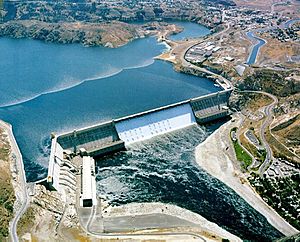List of hydroelectric power stations in the United States facts for kids
Hydroelectric power stations are amazing places where we make electricity using the power of moving water. Imagine a giant waterfall, but instead of just falling, the water spins huge machines called turbines. These turbines then power generators that create electricity! It's a clean way to get energy because it doesn't burn fossil fuels.
This article lists the biggest hydroelectric power stations in the United States that are currently working. Each one can make at least 100 MW of electricity. A megawatt is a huge amount of power, enough to light up thousands of homes!
The famous Hoover Dam in Arizona and Nevada was the first power station in the U.S. to make over 1,000 MW of electricity when it was finished in 1936. Since then, many other hydroelectric stations have grown even bigger. Almost every state in the U.S. has at least one hydroelectric power station, except for Delaware and Mississippi.
Contents
How Hydroelectric Power Works
Making electricity from water is a clever process. There are a few main ways these power stations operate.
Dams and Reservoirs
Many hydroelectric power stations use a large dam to create a reservoir, which is like a giant lake.
- Water is held back by the dam, creating a high-up pool.
- When electricity is needed, gates open, and water rushes down through large pipes called penstocks.
- This fast-moving water spins turbines, which are connected to generators.
- The generators then produce electricity.
- After passing through the turbines, the water flows back into the river below the dam.
This is a very common way to generate hydroelectric power.
Run-of-the-River Systems
Some power stations don't need a huge dam and reservoir. These are called run-of-the-river systems.
- They use the natural flow of a river.
- A smaller dam or barrier might direct some water into a channel.
- This water then flows through turbines to make electricity.
- The water returns to the river quickly.
These systems have less impact on the river's flow and environment.
Pumped-Storage Hydroelectricity
This type of power station is like a giant battery for electricity.
- It has two reservoirs, one high up and one lower down.
- When there's extra electricity available (like at night when people use less power), it's used to pump water from the lower reservoir to the upper one.
- When electricity is needed (like during the day when everyone is using power), the water is released from the upper reservoir.
- It flows downhill through turbines, generating electricity.
- This helps balance the power grid, storing energy for when it's most needed.
Major Hydroelectric Power Stations in the U.S.
The United States has many powerful hydroelectric stations. Here are some of the largest and most important ones, showing how much electricity they can make (their "capacity") and how much they actually produce in a year (their "annual generation").
Grand Coulee Dam
- Location: Washington
- Capacity: 6,809 MW
- Annual Generation: 21,043 GWh (in 2018)
- Type: Reservoir and Pumped-storage
The Grand Coulee Dam is the largest power station in the U.S. and one of the biggest in the world. It's a massive dam on the Columbia River, providing huge amounts of clean energy and helping with irrigation for farms.
Robert Moses Niagara Power Plant
- Location: New York
- Capacity: 2,675 MW
- Annual Generation: 16,773 GWh (in 2018)
- Type: Reservoir
Located near Niagara Falls, this plant uses the powerful flow of the Niagara River to create a lot of electricity for New York State.
Chief Joseph Dam
- Location: Washington
- Capacity: 2,620 MW
- Annual Generation: 12,352 GWh (in 2018)
- Type: Run-of-the-river
Another huge dam on the Columbia River, the Chief Joseph Dam is a major source of electricity for the Pacific Northwest.
Hoover Dam
- Location: Arizona and Nevada
- Capacity: 2,080 MW
- Annual Generation: 3,542 GWh (in 2018)
- Type: Reservoir
The iconic Hoover Dam was a marvel of engineering when it was built. It not only generates power but also helps control floods and provides water for cities and farms.
Bath County Pumped Storage Station
- Location: Virginia
- Capacity: 3,003 MW
- Annual Generation: -983 GWh (in 2018, negative means it uses more power to pump than it generates)
- Type: Pumped-storage
This is the largest pumped-storage facility in the U.S. It's designed to store energy, acting like a giant battery for the power grid.
Ludington Pumped Storage Power Plant
- Location: Michigan
- Capacity: 2,172 MW
- Annual Generation: -698 GWh (in 2018)
- Type: Pumped-storage
Located on the shores of Lake Michigan, this plant also serves as a crucial energy storage facility, helping to keep the lights on when demand is high.
Hydroelectric Power Stations Under Construction
New hydroelectric projects are sometimes built to add more clean energy to the grid. One example is:
Gordon Butte Pumped Storage Project
- Location: Montana
- Expected Capacity: 400 MW
- Expected Annual Generation: 1,300 GWh
- Type: Pumped-storage
This project in Montana will be another important pumped-storage facility, helping to store and release energy as needed.
See also
- List of power stations in the United States by type
- List of hydroelectric power stations in Canada


